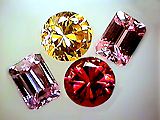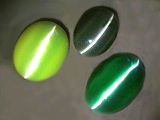![]()
Made-made stones can be divided into two major categories, imitations and true synthetics.
Imitations: are artificial materials which look like a real stone, but have entirely different chemical compositions. Colored glass was used to mimic many real stones in the past, and is an imitation of everything except obsidian. (It could be considered to be a synthetic obsidian.)
Plastic, glass, paste, natural organics, and compressed powders have been used to create simulants (imitation gemstones). There is another category which might lie between imitation and synthetic, and that is composite stones.
A composite might be a quartz bottom and top, sandwiching a thin piece of colored glass or even a thin mineral sample. A faceted top and bottom will reflect the thin slice of color throughout the entire stone, and the only way to easily see it is to look "edge-on" right at the joint.


Cubic Zirconia: is used to simulate a diamond and the composition ZrO2 is not a natural occurring chemical structure. It has hardness of about 8.5, and a specific gravity between 5.65 - 5.95 (gm/cm3). It is very inexpensive and has a dispersion slightly greater than diamond, and this produces an abundance of color play. It is available in a variety of colors. Sample 1 (multicolors) - Sample 2(clear). A radio-frequency "skull crucible" system is used to melt and recrystallize the CZ. Due to its extremely high melting point, (2750 C or 4604 F), it was not synthesized early. The melting zirconia powder actually creates the sides of its own container during its formation.
Strontium Titanate: another simulant with a man-made chemical structure SrTiO3 , but with a much lower hardness, 5.5. It has a much higher dispersion than diamond (0.19), and thus far more color-play. It was produced in some quantity in the mid 1950's, but has been replace by CZ with it's higher hardness, and better diamond matching dispersion. It's known as "Fabulite" in the jewelry industry.
Fiberlite: this is actually fused fiber-optic glass that can be colored during the fusion process, and when cut into cabochons forms a strong catseye. The material is fibrous glass so is actually amorphous. Sample 1 (3 stones) - Closeups of structure, 2 closeup near the catseye (parallel fibers), 3 edge of yellow rough showing linear fibers on the side and bundles at the top, and 4 showing the bundles with fused glass in-between.
Slocum Stone: is another imitation. It appears to be a type of glass, and is used to imitate opal. It is harder and more heat resistant. There are samples and photos in the gemstone section under opal.
Synthetics: have the composition of a known mineral, but do not necessarily match the composition of the gemstone it is to mimic. They may be created by mimicking the natural process, by recrystallizing natural stones, or through an entirely new man-made technology. They share the same chemical structure, and general physical properties with their natural counter parts.
Chatham Ruby: this ruby is very hard to distinguish from natural ruby. It is created from a melt - recrystallization process. It has the same corundum (Al2O3) chemical structure, and shares the same general types of flaws. Sample 1.
Verneuilli Process Corundum: another variety of corundum which is produced by a high temperature fusion of pure aluminum oxide with small amounts of impurities added to provide color. The red rubies created via this process tend to be too pure, flawless, and lack the "ruby-red" color found in the natural stone. They do have the right composition and hardness. The material forms what is known as a "boule", cylindrical shape, tapered at one end.
The Line Company adapted this process to create synthetic star sapphires. They added a small amount of TiO2 (rutile) during the creation phase.
Another similar process, known as the Czochralsky process, is also used to make synthetic corundum. It differs in the way the boule is drawn and twisted as it is removed from the flame zone. It can produce larger diameter boules.
Synthetic Spinel: this is produced by the same process as the corundum, and was originally discovered while trying to use magnesium oxide as a stabilizer for a corundum run. The synthetic material can be made with ratios of aluminum oxide to magnesium oxide of 1:1, 2:1 or even as high as 4:1. It forms very pure colors and flawless gems. It is used to create a specific material that imitates alexandrite with a moderate color change.